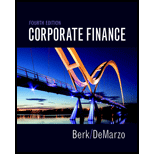
a)
To discuss: The difference between operating cycle and cash cycle.
Introduction:
Cash cycle is also termed as cash conversion cycle that measures the time taken to convert the cash into stocks, accounts payable by the way of sales and accounts receivables and again back to cash.
a)
Explanation of Solution
Operating cycle determines the average length of time taken from the initial cash to produce the item to the cash received from the customers. This includes various factors like payment terms and conditions a company gives its customers and the payment that the company receives from its suppliers.
Cash cycle is also known as cash conversion cycle. This is the time taken by the company to transfer its resources into cash. This involves cyclic effects from purchase of inventory to the amount recovered from the customers. The company’s position indicates positive when it has consistent cash and uses it in various companies’ activities.
b)
To discuss:
Increase in the inventory will affect the cash cycle of the firm, having remaining things, equal.
Introduction:
Cash cycle is also termed as cash conversion cycle that measures the time taken to convert the cash into stocks, accounts payable by the way of sales and accounts receivables and again back to cash.
b)
Explanation of Solution
If the firm’s inventory increases, the inventory days will also increase, having other things to remain the same. This will lead to increase the cash cycle of the firm.
c)
To think critically: The impact on cash cycle if the firm gets discounts from its suppliers.
Introduction:
Cash cycle is also termed as cash conversion cycle that measures the time taken to convert the cash into stocks, accounts payable by the way of sales and accounts receivables and again back to cash.
c)
Explanation of Solution
The impact on cash cycle is that if the firm gets discounts from its suppliers then the accounts payable days will automatically decrease and the rest remains the same. This will lead to the increase in the cash cycle of the firm.
Want to see more full solutions like this?
Chapter 26 Solutions
Corporate Finance Plus MyLab Finance with Pearson eText -- Access Card Package (4th Edition) (Berk, DeMarzo & Harford, The Corporate Finance Series)
- A project requires an initial investment of $100,000 and generates annual cash flows of $20,000 for 5 years. If the discount rate is 10%, what is the project's net present value (NPV)? no ai help ..???arrow_forwarddear expert!!Please don't solve with incorrect values . i will give unhelpful.arrow_forwardWhat is the present value of $2,000 to be received after 3 years, discounted at 10% per annum? A) $1,500.25B) $1,502.63C) $1,450D) $1,800arrow_forward
- If a business buys supplies on credit, which of the following accounts will be affected?a) Supplies and Accounts Payableb) Cash and Suppliesc) Accounts Receivable and Suppliesd) Supplies and Casharrow_forwardPlease don't solve with incorrect values . i will give unhelpful.arrow_forwardA project requires an initial investment of $100,000 and generates annual cash flows of $20,000 for 5 years. If the discount rate is 10%, what is the project's net present value (NPV)? help..??arrow_forward
- You are given the following information concerning four stocks: Using 20X0 as the base year, construct three aggregate measures of the market that simulate the Dow Jones Industrial Average, the S&P 500 stock index, and the Value Line stock index (i.e., a simple average, a value-weighted average, and a geometric average). a. What is the percentage change in each aggregate market measure from 20X0 to 20X1, and 20X0 to 20X2? Why are the results different even though only one stock’s price changed and in each case the price that changed doubled? b. If you were managing funds and wanted a source to compare your results, which market measure would you prefer to use in 20X2? *Show all work & necessary formula(s)arrow_forward7. If the inflation rate is 3% and the nominal return on an investment is 8%, what is the real return approximately? A) 5.0%B) 4.9%C) 5.2%D) 6.0%arrow_forward7. If the inflation rate is 3% and the nominal return on an investment is 8%, what is the real return approximately? A) 5.0%B) 4.9%C) 5.2%D) 6.0%need help properly.arrow_forward
- Which of the following formulas represents compound interest? A) I = PRTB) A = P(1 + rt)C) A = P(1 + r/n)^(nt)D) A = P - Ineed help!arrow_forwardWhich of the following formulas represents compound interest? A) I = PRTB) A = P(1 + rt)C) A = P(1 + r/n)^(nt)D) A = P - Iarrow_forwardA bond pays annual coupons of $60 and is currently priced at $1,050. What is its current yield? A) 6.0% B) 5.7% C) 5.5% D) 5.0% explainarrow_forward
 EBK CONTEMPORARY FINANCIAL MANAGEMENTFinanceISBN:9781337514835Author:MOYERPublisher:CENGAGE LEARNING - CONSIGNMENT
EBK CONTEMPORARY FINANCIAL MANAGEMENTFinanceISBN:9781337514835Author:MOYERPublisher:CENGAGE LEARNING - CONSIGNMENT Intermediate Financial Management (MindTap Course...FinanceISBN:9781337395083Author:Eugene F. Brigham, Phillip R. DavesPublisher:Cengage Learning
Intermediate Financial Management (MindTap Course...FinanceISBN:9781337395083Author:Eugene F. Brigham, Phillip R. DavesPublisher:Cengage Learning Cornerstones of Cost Management (Cornerstones Ser...AccountingISBN:9781305970663Author:Don R. Hansen, Maryanne M. MowenPublisher:Cengage Learning
Cornerstones of Cost Management (Cornerstones Ser...AccountingISBN:9781305970663Author:Don R. Hansen, Maryanne M. MowenPublisher:Cengage Learning Cornerstones of Financial AccountingAccountingISBN:9781337690881Author:Jay Rich, Jeff JonesPublisher:Cengage Learning
Cornerstones of Financial AccountingAccountingISBN:9781337690881Author:Jay Rich, Jeff JonesPublisher:Cengage Learning Financial Reporting, Financial Statement Analysis...FinanceISBN:9781285190907Author:James M. Wahlen, Stephen P. Baginski, Mark BradshawPublisher:Cengage LearningPrinciples of Accounting Volume 1AccountingISBN:9781947172685Author:OpenStaxPublisher:OpenStax College
Financial Reporting, Financial Statement Analysis...FinanceISBN:9781285190907Author:James M. Wahlen, Stephen P. Baginski, Mark BradshawPublisher:Cengage LearningPrinciples of Accounting Volume 1AccountingISBN:9781947172685Author:OpenStaxPublisher:OpenStax College





